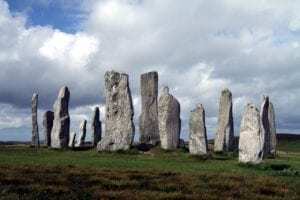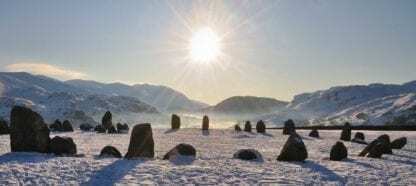Celtic Christianity
Posted by The Celtic Croft on Dec 18th 2016
Originally published December 2000.
Author: Ceilidh Lerwick.
Celtic Christianity
- What does this have to do with Christmas? It is very difficult to separate anything in the ancient world of the Norse. "The Norse?" you may ask "I thought we were talking about Celts?" and I must clarify here that I am using the ancient, very general term which meant Northern people: pretty much any one inhabiting Europe, North Western Asia, Scandinavia and any and all islands connected with said territories.
We get the "Idea" in our modern life that the ancients really kept to their own areas. Someone who was born in ancient Edinburgh would most likely die in ancient Edinburgh and never travel more than 10 miles outside his/her village. The truth is, that was really only true of farmers who were bound to their land to create food and peasants who had no money or no ambition to improve their situation. Even these people did have occasion to travel great distances. Of course, not everyone traveled and you were probably more likely at that time than the present, to find someone who had never left his village. But there was a great deal more traveling than the modern "Joe" is lead to believe.
I interject the above thoughts because it is greatly important to understanding most ancient peoples, including the Celts. For those of you that don't know, the Celts, at one time, had as big of an "Empire" as Rome spanning pretty much the same territory as well (Turkey to Spain). I use "Empire" loosely because the Celts weren't very good at organization. Between the Celts raiding, the Romans conquering and the Vikings doing a little of both (not to mention the countless intermarriages) it is often hard to separate one set of peoples and beliefs from another. In fact, at one point the Romans themselves got fed up with trying to figure out who was German and who was Celtic so they just said "Every one north east of the Rhine is German and everyone south east of the Rhine is Celt".

With only an oral tradition that was eventually suppressed and lost many of its stories and accurate information, it is also hard to know when anything really happened. So, there is, conflicting information on when the Celts actually began to accept Christianity and who brought the concept to them in the first place. But most scholars seem to agree that Christianity was a powerful influence to the Celts by the 5th Century AD, well into Roman rule.
Now, the Celts are famous for squabbling and the Romans didn't like squabbles. Once they conquered an area they wanted life to be peaceful and they often made huge concessions to "smooth things over". And one of the major changes or concessions the Romans made was to set the Christian High Holidays to the dates of already existing pagan festivals. This seemed to make it easier for someone to become a Christian ("it wasn't much different than what you were already doing"), and to make it look more like what was already going on. That way the locals weren't overly offended if there was an increasing number of Christians in the area.
It wasn't just the Celts that the Romans were concerned about when they made these convenient holidays, but remember my opening paragraphs about the lines between different peoples being hazy. Take the Christmas holiday for example (since it is that time of year). The Celts call it Alban Arthuan, the Scandinavians and Germans call it Yule, but it is pretty much the same festival celebrating the return of the Sun at the Winter Solstice. The actual date of the Christmas celebration seems to have fluctuated a bit for a few years until December 25th was officially adopted by Bishop Liberius of Rome in 354. The ancient, pre-Christian Roman God Mythra, whose story seems to have some similarities to the Christ Child, was said to have been born on December 25th and that may have had something to do with the final decision.
Yule was celebrated by cutting mistletoe, any man and woman found under the mistletoe would have to kiss (among other things). Holy and Ivy were hung everywhere. In many areas, the Yule Tree was cut, placed inside people's homes and decorated with colors and lights. The Yule log was placed in the fire to burn about as long as it was able (sometimes all winter). Sound familiar?

Of course, the Romans changed things a bit: the tree now represented The Christ, the only tree to overcome the "death" of winter and Christ being the only person to overcome the death of the flesh; the red of the holly berries representing the Blood of Christ, etc. But otherwise the original Christmases were pretty much the same old same old to the ancient pagans.
Amazingly, with all the fighting and grumbling the Celts did, there doesn't seem to have been a huge resistance to Christianity. The pre-Christian nature mysticism became almost like the Old Testament of the Celts. The Irish poet Yeats wrote of the "great tapestry" behind Irish history: "Nobody looking at its dim folds can say where Christianity begins and Druidism ends."
The gospel was seen as a fulfilling rather than destroying the old Celtic mythologies. An old 6th century bard claimed that the Christ had always been the Celts' teacher, but they had not known him by name. Somewhat akin to Paul's address to the Athenians, "Men of Athens, I notice that you are very religious, for as I was out walking I saw your many altars, and one of them had this description on it - ' To the Unknown God.' You have been worshiping him without knowing who he is, and now I wish to tell you about him." (Acts 17:16 - 34)"

